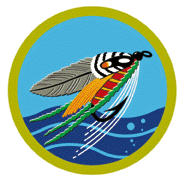| MERIT BADGES |
|
|
|
|
| Note: Eagle Required are in Italics |
"A"
American
Business
American Culture
American Heritage
American Labor
Animal Science
Archaeology
Archery
Architecture
Art
Astronomy
Athletics
Atomic Energy
Auto Mechanics
Aviation
"B"
Backpacking
Basketry
Bird Study
Bugling
"C"
Camping
Canoeing
Chemistry
Cinematography
Citizenship
Community*
Citizenship Nation*
Citizenship World*
Climbing
Coin Collecting
Collections
Communications*
Computers
Cooking
Crime Prevention
Cycling*
"D"
Dentistry
Disability Awareness
Dog Care
Drafting
"E"
Electricity
Electronics
Emergency
Preparedness**
Energy
Engineering
Entrepreneurship
Environmental
Science*
"F"
Family Life*
Farm Mechanics
Fingerprinting
Fire Safety
First Aid*
Fish & Wildlife Mgmt.
Fishing
Fly Fishing
Forestry
"G"
Gardening
Genealogy
Geology
Golf
Graphic Arts
"H"
Hiking
Home Repairs
Horsemanship
"I"
Indian Lore
Insect Studies
"J"
Journalism
"K"
"L"
Landscape Architecture
Law
Leatherwork
Lifesaving**
"M"
Mammal Study
Medicine
Metalwork
Model Design & Building
Motorboating
Music
"N"
Nature
"O"
Oceanography
Orienteering
"P"
Painting
Personal Fitness**
Personal Management*
Pets
Photography
Pioneering
Plant Science
Plumbing
Pottery
Public Health
Public Speaking
Pulp and Paper
"Q"
"R"
Radio
Railroading
Reading
Reptile & Amphibian Study
Rifle Shooting
Rowing
"S"
Safety
Salesmanship
Scholarship
Sculpture
Shotgun Shooting
Skating
Skiing
Small Boat Sailing
Soil & Water
Conservation
Space Exploration
Sports**
Stamp Collecting
Surveying
Swimming**
"T"
Textile
Theatre
Traffic Safety
Truck Transportation
"U"
"V"
Veterinary Medicine
"W"
Water Skiing
Weather
Whitewater
Wilderness Survival
Wood Carving
Woodwork
"X"
"Y"
"Z"
 Fly Fishing
Fly FishingRequirements 2002 |
-
Explain to your counselor the injuries that could occur while fly-fishing and the proper treatment, including cuts, scratches, puncture wounds, insect bites, hypothermia, and heat reactions. Explain how to remove a hook that has lodged in your arm. Name and explain five safety practices you should always follow while fly-fishing.
-
Discuss how to match a fly rod, line and leader to get a balanced system. Discuss several types of fly lines, and explain how and when each would be used. Review with your counselor how to care for this equipment.
-
Demonstrate how to tie proper knots to prepare a fly rod for fishing:
-
Tie a backing to a fly reel spool using the arbor backing knot
-
Attach backing to fly line using the nail knot
-
Attach a leader to fly line using the needle knot, nail knot or loop-to-loop connection
-
Add tippet to a leader using a double surgeonís loop or blood knot
-
Tie a fly onto the terminal end of the leader using the improved clinch knot
-
-
Explain how each of the following types of flies are used: dry flies, wet flies, nymphs, streamers, bass bugs and poppers. What does each imitate? Tie at least two types of the flies mentioned in this requirement.
-
Demonstrate the ability to cast a fly consistently and accurately using overhead and roll cast techniques.
-
Go to a suitable fishing location and make observations on the types of insects fish may be eating. Look for flying insects and some that may be on or beneath the waterís surface. Look under rocks. Explain the importance of matching the hatch.
-
Explain the importance of practicing Leave No Trace and how it positively affects fly-fishing resources.
-
Obtain a copy of the regulations affecting game fishing where you live. Explain why they were adopted and what you accomplish by following them.
-
Explain what good outdoor sportsmanlike behavior is and how it relates to fishermen. Tell how the Outdoor Code of the Boy Scouts of America relates to a fishing enthusiast, including the aspects of littering, trespassing, courteous behavior, and obeying fishing regulations.
-
Using the fly-fishing techniques you have learned, catch two different kinds of fish and identify them. Release at least one of them unharmed. Clean and cook another fish.
|
||||||
Last Update May 15, 2023

.jpg)
